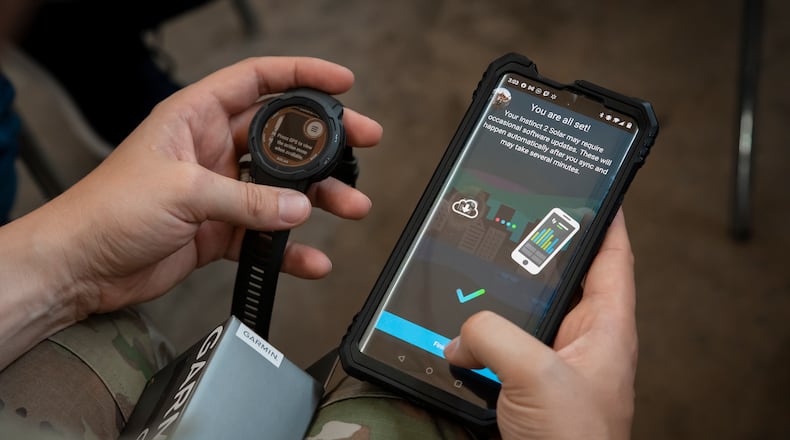Anything services leaders can do to help members get and stay fit “enables us to meet the really big goals of defending the national interest,” Christensen said.
“That’s essentially the goal,” he said.
There are more than 5,800 participants in the test, including about 150 enrolled at Wright-Patterson. Response was “a little larger than we expected, and very positive,” Christensen said.
According to AFRL, 71% of all Guardians are enrolled, including 69% of male Guardians and 76% of women Guardians.
Exemption from regular annual Air Force physical tests may have had something to do with that enthusiasm. (Space Force is part of the Department of the Air Force, just as the Marine Corps is part of the Department of the Navy.)
Study organizers hope better tracking of exercise habits over a longer duration of time will lead to better fitness with fewer injuries.
“This is essentially a very large pilot program,” Christensen said.
The AFRL study will have participants wearing Garmin watches to gather data about their physiology and fitness.
A smart phone app used in the study will take that data and render it so that users can easily see how they’re doing.
“The idea of using wearables to track fitness, I think, is not new,” said Dr. Adam Strang, a product area lead for AFRL and a certified athletic trainer.
What might be new: Shedding light on how a familiar technology may boost operations and define policy.
“You can think of this as sort of crowd-sourcing the Guardians ... to help define the policy and the capability for themselves,” Strang said.
Strang said regular Air Force physical fitness tests typically happen once or twice a year. Airmen and Guardians schedule the test and perform required activities under supervision, usually in less than hour.
There are variations, but the basic test involves a 1.5-mile run, with the option of a shuttle run or timed sprints. Airmen are also expected to perform push-ups and sit-ups, as many as they can manage in a minute’s time.
The results can have implications for careers. At lower ranks, poor test results can delay promotions or end careers.
While tests today can be done almost anywhere and don’t require special equipment, they can promote “sort of a cramming” for the once-a-year test, Christensen said.
“You don’t necessarily work out very much for a lot of the year,” he said with a laugh. “You can kind of work yourself into shape quickly if needed. Then in the month or two before the test, ‘OK, it’s time to go out and run again. I have pass my test.’”
So the downside of annual tests can be periods of relatively poor fitness, with a higher risk of injury when members push themselves to prepare.
“Our hope is that regular moderate physical activity will provide benefits to the force in terms of a higher performing, more ready force,” Christensen said.
Study leaders say only the study team will monitor individual performance, and personal information will not be shared with commanders during the study.
“There’s no way to attach anybody’s personal information to the data flowing from the watch,” Michael Hanke, the cybersecurity authorizing official for Air Force science and technology activities, said in an AFRL release. “That information is protected and behind firewalls. Very few people will have access to it and [the personal info] is not intended for any other purposes than study management to ensure participation.”
Wright-Patterson is home to 35,000 military and civilian employees, working for both the Air Force and Space Force. It’s the largest single-site employer in Ohio.
About the Author


